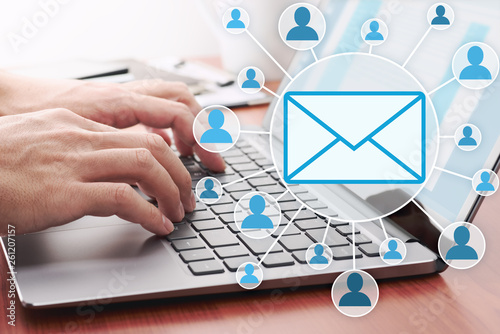Basics of Email
Electronic mail, or email for short, is an online message delivery system. It delivers private messages to individuals and groups. These messages are delivered to the recipient’s email inbox, usually within seconds. You can attach files to email messages and even put images within the message body.

Types of email accounts
-
Web-based: This type of email account is designed to be used primarily with a web-based interface. Many of the free email services are this type, including Gmail, Hotmail (now part of Outlook.com), and Yahoo! Mail. This is the easiest, most no-fuss type, and is great for casual users who don’t send many messages and don’t want to fool with setting up an email program.
-
POP3: This type of email account is designed to be used with an email client, although the provider may also allow web access too. This type of account downloads your received messages to your local PC when it connects to the mail server.
A POP3 account is tethered to a particular computer where the received mail is stored; it’s best for someone who uses the same computer all or most of the time. POP3 stands for Post Office Protocol version 3.
-
IMAP: This type of email account, like POP3, is also designed to be use with an email client. It does not download received messages, though; it reads them from the server, like web-based email does. That way, you can browse your mailbox from multiple computers and still see the full set of emails.
The downside is that you can’t browse your mail if you aren’t connected to the Internet. IMAP stands for Internet Mail Access Protocol.
-
EAS: This type is similar to IMAP except it is used by Exchange servers. It is a popular type of account for groupware and corporate accounts, as well as for mail delivered to smart phones. EAS stands for Exchange ActiveSync.

The Pros and Cons of Email
The Pros
- It’s fast. Most messages are delivered within minutes – sometimes seconds – around the world without the inconvenience and cost of using s postal service. In fact, postal service is often referred to as “snail mail” by email users.
- It’s personal. While the nature of email is informal, its efficiency is an excellent
substitute for telephone conversations. - You can think through your response. Like a letter, you can type your reply and make changes before sending.
- The sender and the receiver don’t have to be working at the same time. Email avoids problems such as telephone tag or trying to contact someone in a different time zone.
- Email makes it easy to keep a record of your communication. You can save and refer to later copies of the emails you send as well as those you receive.
- You can reach a lot of people at once. It is possible to send one message to hundreds of recipients at once, or you can send a private message to one individual.
The Cons
- Junk Mail (also known as Spam). This is as annoying in email as it is with traditional mail. Try not to send unnecessary messages.
- Ads. The reason you can get free email services like Yahoo is because of advertisements. You pay the price of having to click around them to read your mail.
- Misinterpretation. Email arrives without tone or hand gestures which can lead to
misunderstandings. - Email messages can be passed on to others. You should always count on the possibility of your message ending up in the inbox of someone it wasn’t intended for.
- You can hide behind email. It’s tempting to use email instead of facing a person when you have to deal with an unpleasant situation. It’s best to talk to a person face-to-face under these circumstances.
0 Comments